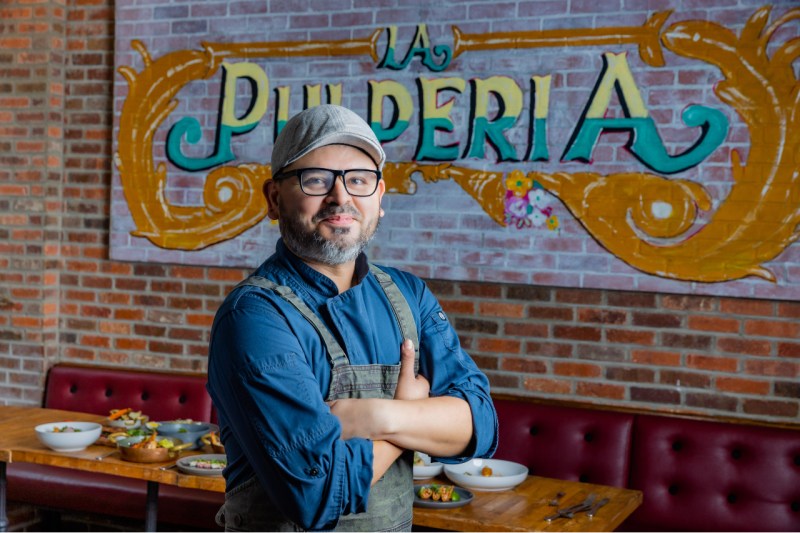Perfectly al-dente rice flush with fresh shellfish, a properly made seafood paella is one of the greatest foods in the world. This delicacy from Valencia, Spain, is the perfect dish for a festive gathering, a fun family meal, or a romantic dinner for two. While it can be made with poultry and game meat in Spain, some of the most popular versions of paella often lean heavily into seafood.
At La Pulperia, a pan-Latin American restaurant in Hell’s Kitchen, Manhattan, they’ve mastered the seafood paella. Executive Chef Miguel Molina is a native of Guerrero, Mexico, and is lending his creativity and culinary background to the restaurant menu, which includes a stellar paella made with black squid ink. The food here is a blend of cultures, combining influences from Latin and South American countries like Peru, Brazil, Argentina, and Mexico, creating totally distinctive flavor combinations. So what better guide is there to help us on the journey of making a world-class paella?
The foundation: The rice

At its core, paella is a rice dish; therefore, it should come as no surprise that the key component of a world-class paella is mastering the rice.
“Buy the best Spanish paella rice you can get your hands on; it will make a huge difference, even if you have to order it online,” said Molina.
Not just any white rice will work, though. If you make paella with standard medium-grain white rice or Thai jasmine rice, your paella will taste off and not as it should. The key is obtaining bomba rice, a variety of short-grain rice cultivated in Valencia. What makes bomba rice essential is its ability to absorb large amounts of stock — three times its volume in liquid. This factor is critical because the finished paella rice will still be in distinct grains and never mushy if cooked properly.
However, cooking bomba rice well will take some practice — and skill.
“Don’t overcook the bomba rice. It will definitely affect the final result,” said Molina. “Done properly, in 15 minutes, you should be having a fully cooked paella ready to serve. Make sure to add the seafood only about five minutes before the rice is ready. It’s upsetting to have the rice cooked on point with seafood overcooked. Timing is key here.”
The seafood

Regarding the seafood choices for seafood paella recipe, the list is endless. Should you add shrimp? How about shellfish, like clams and mussels? Perhaps the best is a combination of all three. Before you cook, consider three components: Quality, a tasty sofrito, and a good fish broth.
Known as fumet, an excellent fish broth will flavor the rice as it cooks, giving your paella that coveted fragrance. A sofrito, made from vegetables and aromatics, is also key and an important element of Spanish cuisine. In fact, Molina describes these two components as “the base flavor of the paella.” While you can buy pre-made fish broth or sofrito in specialty grocery stores, you should try making it at home. This not gives you the added benefit of freshness, but you can also control the level of seasonings and ingredients.
Now for the chunks of seafood. Almost any kind of shellfish and fish will work for seafood paella. In fact, a variety of seafood is the best option. Not only does it look fantastic, but it will also give the paella a complex flavor. Just remember to add the different types of seafood in stages. The fish and squid can be cooked and mixed into the rice, but items like shrimp or clams are better placed over the top of the rice when it’s almost cooked. These steps will ensure great presentation and avoid any overcooking of the shrimp.
One ingredient that Molina likes to add to his paella is briny squid ink, giving his paella a rich flavor and amazing black color. To use, Molina adds “a tablespoon of squid ink, mid-process — that is, about seven minutes into cooking the rice. A tablespoon is more than enough; it’s a strong and salty flavor, so you want to make sure you do not overdo the flavor.”
Pair your paella with a great cocktail or wine

Finally, to truly enjoy a world-class paella, it’s time to break out the wine bottle or cocktail shaker. Since seafood pairs well with citrus flavors, any cocktail that highlights lime, lemon, orange, or another bright flavor will accentuate that bite of seafood paella. Think outside the box and pair cocktails like a Brazilian caipirinha or classic mojitos, and you won’t be disappointed.
For that classic pairing, nothing beats a glass of wine with your seafood. For wine, the idea is the same as cocktails — something bright.
“I’d say for wines, you can accompany sauvignon blanc or pinot grigio,” said Molina. “For drinks, depending on the person’s choice, I would recommend something fresh and citrus to give it that fresh final touch to the entire meal.”



